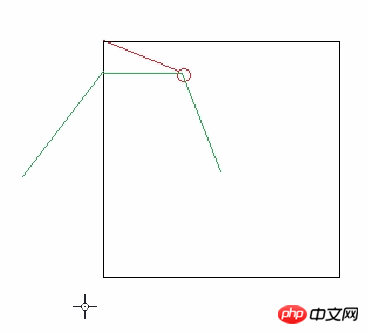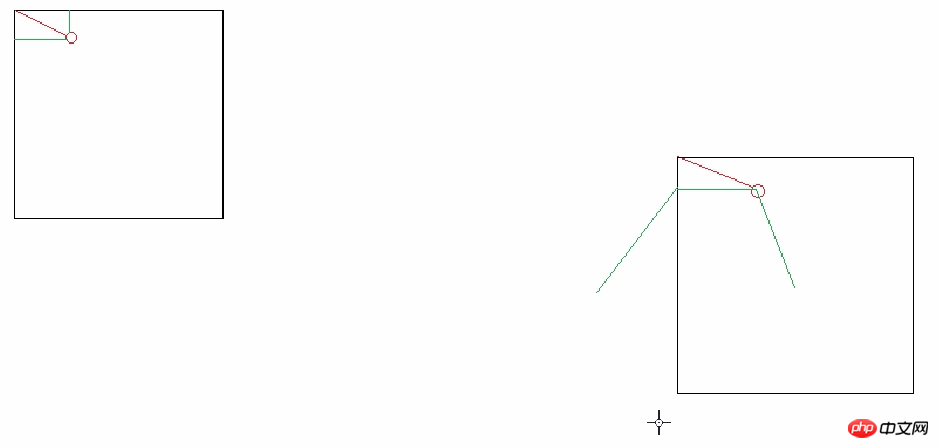Javascript drag and drop prototype
This article mainly introduces the prototype of Javascript drag and drop (analyzing the code line by line, allowing you to easily understand the principle of drag and drop). Friends in need can refer to the
principle of drag and drop: In fact, it is the mouse and The distance from the top left corner remains the same. Let’s look at the picture below:

This red dot is the mouse.
Drag-drag actually means calculating the position of an object through the position of the mouse. It’s that simple and it’s so willful. So how do you find this distance? ?
The difference between the mouse position and the object position is the distance, right? Then this diagonal line is composed of horizontal lines and vertical lines.

Let’s take a look at how to do the program.
<p id="p1"></p>
In fact, what he changed was the left top of a certain p, and then he started to move. There must be absolute positioning in that method, right?
<style type="text/css">
#p1 {
width: 200px;
height: 200px;
background: red;
position: absolute;
}
</style>There are several steps here, 1. Mouse down 2. Mouse up 3. Mouse movement
<script type="text/javascript">
window.onload = function() {
var op = document.getElementById("p1");
var disX = 0;
var disY = 0;
op.onmousedown = function(ev) {
var oEvent = ev || event; // 浏览器兼容
disX = oEvent.clientX - op.offsetLeft; // 横向的位置就是鼠标的位置-p的位置
disY = oEvent.clientY - op.offsetTop;
};
op.onmousemove = function(ev) {
var oEvent = ev || event;
op.style.left = oEvent.clientX - disX+'px'; // 当前鼠标的位置-disX
op.style.top = oEvent.clientY - disY+'px';
};
};
</script>Look at the picture and talk:

var opLeft = oEvent.clientX - disX;
The picture shows it very clearly

mouseup Let’s not take a look at the effect now. .

You will find a very interesting phenomenon. The mouse will follow me even if I don’t click it. Why is this? ? ?
Let’s take a look at mousemove: No one in Javascript stipulates that the mouse must be pressed before starting, right? Regardless of whether you press the mouse or not, this mousemove keeps happening, so the problem comes from here. Before the mouse is pressed down, there should be no response when the mouse is moved over it. It will only respond when the mouse is pressed down.
So, this mousemove should not be added as soon as it comes up, but wait until the mouse is pressed before adding mousemove. Let’s take a look at the modified code.
Add mouseup by the way, and then its role will be reflected. The function is op.onmousemove = null; remove the move event,
Otherwise, when you lift the mouse, the object will still follow you. op.onmouseup = null; Without leaving garbage, raising the mouse is useless.
Let’s take a look at the modified code:
<script type="text/javascript">
window.onload = function() {
var op = document.getElementById("p1");
var disX = 0;
var disY = 0;
op.onmousedown = function(ev) {
var oEvent = ev || event; // 浏览器兼容
disX = oEvent.clientX - op.offsetLeft; // 横向的位置就是鼠标的位置-p的位置
disY = oEvent.clientY - op.offsetTop;
op.onmousemove = function(ev) {
var oEvent = ev || event;
op.style.left = oEvent.clientX - disX+'px'; // 当前鼠标的位置-disX
op.style.top = oEvent.clientY - disY+'px';
};
op.onmouseup = function() {
op.onmousemove = null;
op.onmouseup = null; // 不留垃圾,鼠标抬起本来也就没有用了
};
};
};
</script>Now we have made a simple Drag it out. Of course, there are still some small problems that need to be solved.
But no matter what, we already have a prototype of drag and drop.
The above is the entire content of this chapter. For more related tutorials, please visit JavaScript Video Tutorial!

Hot AI Tools

Undresser.AI Undress
AI-powered app for creating realistic nude photos

AI Clothes Remover
Online AI tool for removing clothes from photos.

Undress AI Tool
Undress images for free

Clothoff.io
AI clothes remover

Video Face Swap
Swap faces in any video effortlessly with our completely free AI face swap tool!

Hot Article

Hot Tools

Notepad++7.3.1
Easy-to-use and free code editor

SublimeText3 Chinese version
Chinese version, very easy to use

Zend Studio 13.0.1
Powerful PHP integrated development environment

Dreamweaver CS6
Visual web development tools

SublimeText3 Mac version
God-level code editing software (SublimeText3)

Hot Topics
 1386
1386
 52
52
 What should I do if I encounter garbled code printing for front-end thermal paper receipts?
Apr 04, 2025 pm 02:42 PM
What should I do if I encounter garbled code printing for front-end thermal paper receipts?
Apr 04, 2025 pm 02:42 PM
Frequently Asked Questions and Solutions for Front-end Thermal Paper Ticket Printing In Front-end Development, Ticket Printing is a common requirement. However, many developers are implementing...
 Who gets paid more Python or JavaScript?
Apr 04, 2025 am 12:09 AM
Who gets paid more Python or JavaScript?
Apr 04, 2025 am 12:09 AM
There is no absolute salary for Python and JavaScript developers, depending on skills and industry needs. 1. Python may be paid more in data science and machine learning. 2. JavaScript has great demand in front-end and full-stack development, and its salary is also considerable. 3. Influencing factors include experience, geographical location, company size and specific skills.
 How to merge array elements with the same ID into one object using JavaScript?
Apr 04, 2025 pm 05:09 PM
How to merge array elements with the same ID into one object using JavaScript?
Apr 04, 2025 pm 05:09 PM
How to merge array elements with the same ID into one object in JavaScript? When processing data, we often encounter the need to have the same ID...
 Demystifying JavaScript: What It Does and Why It Matters
Apr 09, 2025 am 12:07 AM
Demystifying JavaScript: What It Does and Why It Matters
Apr 09, 2025 am 12:07 AM
JavaScript is the cornerstone of modern web development, and its main functions include event-driven programming, dynamic content generation and asynchronous programming. 1) Event-driven programming allows web pages to change dynamically according to user operations. 2) Dynamic content generation allows page content to be adjusted according to conditions. 3) Asynchronous programming ensures that the user interface is not blocked. JavaScript is widely used in web interaction, single-page application and server-side development, greatly improving the flexibility of user experience and cross-platform development.
 The difference in console.log output result: Why are the two calls different?
Apr 04, 2025 pm 05:12 PM
The difference in console.log output result: Why are the two calls different?
Apr 04, 2025 pm 05:12 PM
In-depth discussion of the root causes of the difference in console.log output. This article will analyze the differences in the output results of console.log function in a piece of code and explain the reasons behind it. �...
 How to achieve parallax scrolling and element animation effects, like Shiseido's official website?
or:
How can we achieve the animation effect accompanied by page scrolling like Shiseido's official website?
Apr 04, 2025 pm 05:36 PM
How to achieve parallax scrolling and element animation effects, like Shiseido's official website?
or:
How can we achieve the animation effect accompanied by page scrolling like Shiseido's official website?
Apr 04, 2025 pm 05:36 PM
Discussion on the realization of parallax scrolling and element animation effects in this article will explore how to achieve similar to Shiseido official website (https://www.shiseido.co.jp/sb/wonderland/)...
 Can PowerPoint run JavaScript?
Apr 01, 2025 pm 05:17 PM
Can PowerPoint run JavaScript?
Apr 01, 2025 pm 05:17 PM
JavaScript can be run in PowerPoint, and can be implemented by calling external JavaScript files or embedding HTML files through VBA. 1. To use VBA to call JavaScript files, you need to enable macros and have VBA programming knowledge. 2. Embed HTML files containing JavaScript, which are simple and easy to use but are subject to security restrictions. Advantages include extended functions and flexibility, while disadvantages involve security, compatibility and complexity. In practice, attention should be paid to security, compatibility, performance and user experience.
 Is JavaScript hard to learn?
Apr 03, 2025 am 12:20 AM
Is JavaScript hard to learn?
Apr 03, 2025 am 12:20 AM
Learning JavaScript is not difficult, but it is challenging. 1) Understand basic concepts such as variables, data types, functions, etc. 2) Master asynchronous programming and implement it through event loops. 3) Use DOM operations and Promise to handle asynchronous requests. 4) Avoid common mistakes and use debugging techniques. 5) Optimize performance and follow best practices.




